B2B E-Commerce: What Is It & What Do You Need To Know?

B2B ecommerce is the online marketing and sale of products between two firms.
The idea is straightforward: To increase client reach while decreasing cost-to-serve to increase revenue for your company.
But how does one get started in B2B ecommerce, and what does the future hold?
Don't worry if you're unfamiliar with this ecommerce model. This article will teach you how it works, how to get started on a B2B ecommerce platform, and successful B2B ecommerce examples to help you get started.
How Does It Work?
Selling items and services directly between two firms is called "business-to-business" (B2B). B2B differs significantly from the B2C model, in which businesses sell now to consumers. B2B ecommerce involves online sales portal transactions between a manufacturer and a wholesaler or a retailer.
B2B ecommerce is one of the most rapidly developing sales models. According to some estimates, the global B2B ecommerce sector is worth more than $12 trillion, accounting for 13% of total B2B sales in the United States.
B2B ecommerce platforms' innovation and technology have propelled this development. B2B sales and marketing procedures have typically been labour-intensive and manual. Through ecommerce automation, the introduction of digital commerce helps these organisations decrease costs and improve productivity.
B2B vendors collaborate with:
~Wholesalers
~Major retailers
~Schools and non-profit organisations
~Resellers
Buyers and sellers may now meet in a single digital home, placing and managing orders from their mobile phones and opening up new communication channels for businesses to engage with distributors and suppliers.
"The ability to automate the entire process alters how we create our team." It keeps us from missing 2 am orders and our consumers from waiting until we're in the office to place an order. It addresses so many issues." Said Laird Superfood CEO Paul Hodge.

Key Advantages?
The following are some of the primary benefits of B2B ecommerce:
~Sales operations involving enterprises, suppliers, and distributors that are automated.
~Infrastructure and overhead costs have been reduced.
~Reduced reliance on intermediaries, increased growth potential.
~Capability to reach a large number of people on a large scale.
~Omnichannel branded presence available 24 hours a day, seven days a week.
~Improved partner relationships.
~High levels of employee productivity.
The COVID pandemic exposed numerous problems in supply chains and B2B operations. The shift to online selling was a silver lining. While moving your entire B2B organisation online may appear daunting, those who do reap the rewards of improved customer experience, streamlined ordering, and new revenue sources for their company.
What’s In Store?
The trend is clear: B2B ecommerce is a significant sales channel in digital commerce. Changes in buying behaviour as a result of the epidemic will boost adoption well beyond 2021. According to Forrester, B2B ecommerce transactions will exceed $1.8 trillion by 2023, accounting for 17% of all B2B sales in the United States.
Of course, emails and phone calls remain important in B2B transactions. Still, there's no denying that ecommerce is pushing the frontiers of what B2B sales can be.
Because purchasers are shifting, this is terrific news for B2B sellers. Millennials, the generation who grew up with technology, account for over 73% of B2B buyers. These new purchasers have higher expectations for convenience and relevance than their baby boomer and Generation X peers.
B2B platforms continue to pave the way for cost-effective and accessible selling options, with personalised sales portals, mobile ordering, AR tours, and self-service features.
Consider what that means:
~With fewer resources, you can reach a large number of people.
~Relationships can be personalised on a large scale.
~Customers can now serve themselves.
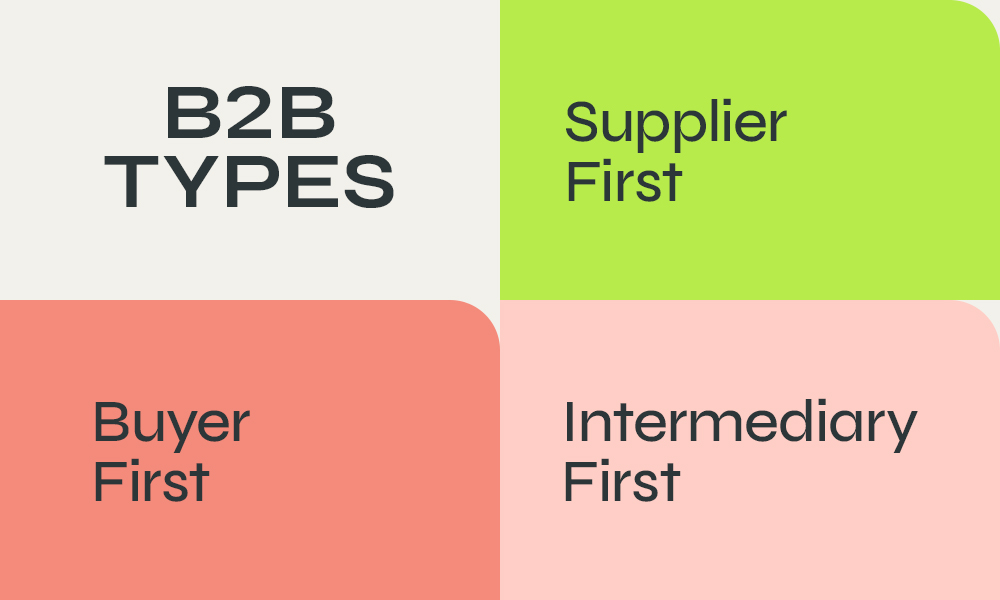
B2B Types?
If you're new to B2B ecommerce, you'll most likely fall into one of the three categories listed below. Each has advantages and disadvantages, and many businesses operate in numerous categories simultaneously.
• Supplier First
This strategy is common for B2B sellers with many buyers but only a few suppliers. Businesses may frequently join supplier directories or set up an online sales platform to meet demand and sell at scale. This strategy allows suppliers to manage price and the customer experience, which aids in developing long-term partnerships with B2B buyers.
• Buyer First
Buyer-oriented marketplaces exist in areas where there are more buyers than sellers. In this instance, buyers have their internet markets. They invite suppliers and manufacturers to display their wares and receive bids from various merchants.
If you're a wholesale supplier, these B2B marketplaces can help you display your items to buyers and retailers while requiring less marketing effort.
• Intermediary First
A third party matches buyers and vendors in the intermediary-oriented economy. Because the middleman owns the product catalogues and information, you must adhere to specific standards. It also controls the buyer's orders, contact information, and relationship.
B2B ecommerce sites such as Amazon Business, Alibaba, AliExpress, Rakuten, or TradeKey are examples of intermediary-oriented markets, often known as "horizontal marketplaces."
B2B E-Commerce Platforms?
B2B ecommerce firms frequently use legacy platforms. They used to sell to B2B customers via faxes, phone calls, and Excel spreadsheets.
Businesses can now use B2B ecommerce systems to satisfy the needs of their online customers. These platforms aid in the creation of an online experience that increases sales and executes orders regardless of where your buyers are.
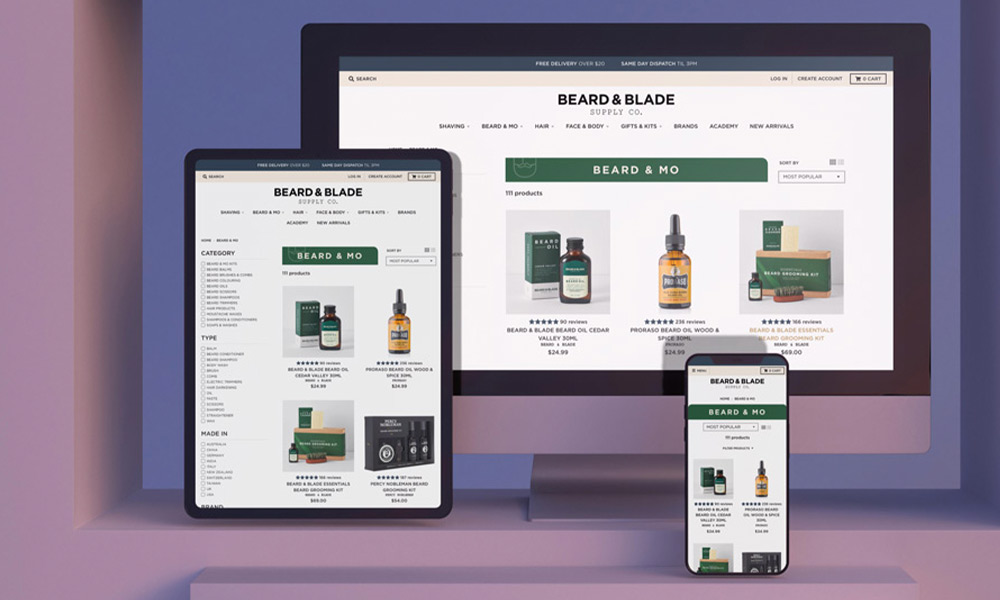
While many believe that a B2B ecommerce platform is only a tool for listing products and accepting payments, a true one is much more. It serves as a command centre from which you can manage everything from sales to commerce operations, whether for B2B and wholesale customers or a D2C website.
A B2B ecommerce website, for example, allows you to:
~ Personalise sales and marketing experiences across all sales channels and devices.
~With onsite search and personalised navigation, you can assist clients in finding products.
~Integrate customer data from your ERP or CRM using trusted APIs.
~Provide flexible payment choices through various payment providers and manual invoicing.
~Boost conversions with effective checkout incentives.
If you're starting in wholesale, a B2B ecommerce solution can help you:
~Create special pricing and promotions for specific consumer groups.
~New buyer signups should be automated and reviewed.
~Allow B2B clients to buy, track, and reorder products effortlessly.
~Connect a current ecommerce business or third-party software to sync inventory, purchase orders, and customers.
"The wholesale portal will save us the equivalent of one staff each year." That's $50,000 to $60,000 per year, which more than covers the cost of setup." States Laird Superfood CEO Paul Hodge.
Finally, a great B2B ecommerce platform allows you to handle everything from one location, with limitless development potential.
Best Practices?
Understanding how B2B brands succeed is essential for navigating B2B in ecommerce.
Give B2B ecommerce the B2C treatment
The development of e-commerce has resulted in enormous upheavals in the B2B marketplace. Some of these shifts have brought with them a slew of B2C best practices:
~Images and videos of high quality.
~Strong onsite search combined with visual merchandising.
~Flexible shipping options and order updates provide social evidence through reviews and ratings.
~Personalised content based on previous purchases.
~Mobile-specific stores.
~Catalogues available online for convenient viewing.
~Product and supply availability in real-time.
~Chat and phone help are available for customers.
Fortunately, solving those issues does not necessitate guesswork. The following B2C skills are becoming essential to business customers' online shopping experiences:

~Online access to product information.
~Pricing and buyer experience that is tailored to the individual.
~The ease and quickness.
W. W. Grainger, a Fortune 500 industrial supply company, is an example of this expanding overlap. Buyers are brought to a webpage resembling any B2C site after creating an account. Similarly, their product pages exhibit all of the B2C characteristics stated above:
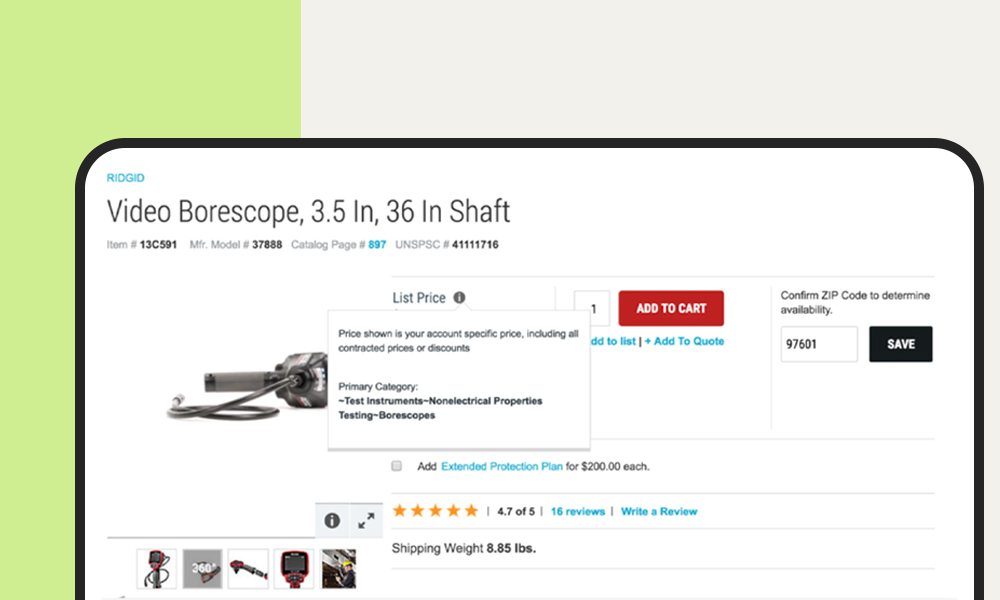
Three other traits, however, distinguish Grainger as an online B2B pioneer. First, three purchasing programmes that go above and beyond auto-reordering to accommodate the size and demands of particular businesses:
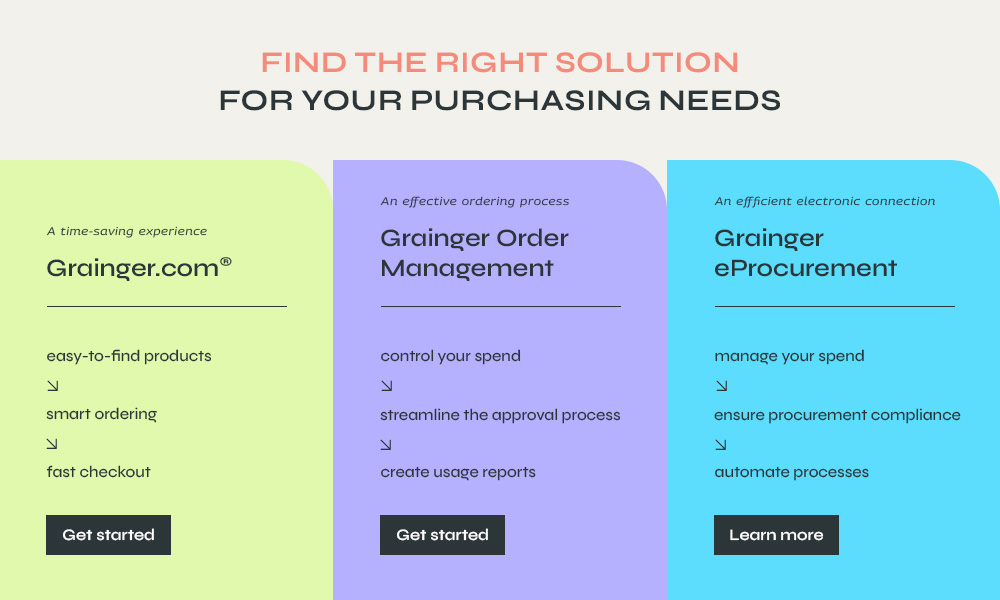
Second, a "Bulk Order Pad" toggles between two entry possibilities next to the search bar. Third, a powerful autocomplete search bar with "Add to Cart" buttons:
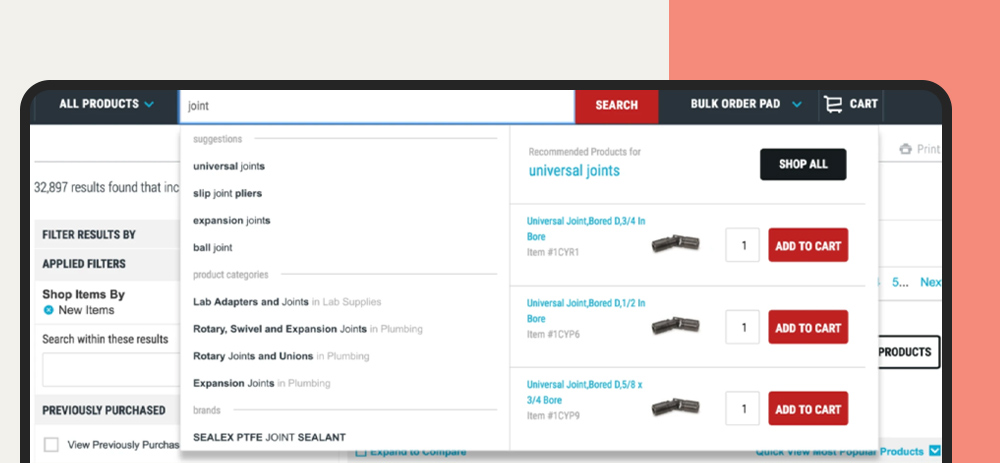
Given that 75% of B2B clients shop online and 47% conduct internet research before making a purchase. Improved onsite search capabilities are critical.
Improve the Functionality of Your Onsite Search.
Customers will need help finding what they're looking for on your B2B ecommerce website if you sell an extensive catalogue of thousands of car components.
Site search is becoming a required website function in the B2C world. It assists clients in finding and purchasing the right products, much like an in-store sales assistant. Customers that utilise site search are nearly twice as likely to convert to your site and can generate up to 40% of your site's income.
Improving your onsite search for B2B customers is also crucial because it helps to shorten the sales process, allowing your sales professionals to operate in a consultative rather than transactional manner.
HubSpot Advisor and former Chief Revenue Officer Mark Roberge explain:
"You know you're running a modern sales team when selling feels more like a doctor-patient relationship and less like a salesperson-prospect one."
"It's not about interrupting, pitching, and closing anymore." It all comes down to listening, diagnosing, and prescribing."
The V-Belt Guys' website could be more attractive and content-rich. But it doesn't have to be that way. Instead, they prioritise first.
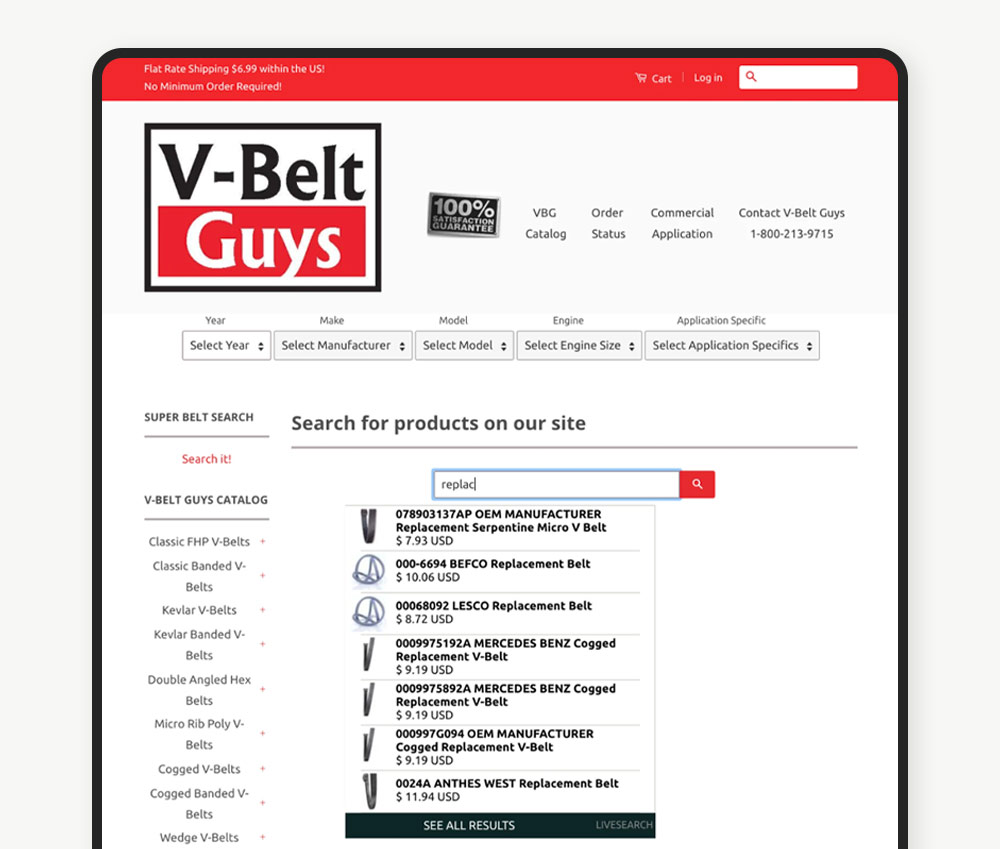
On the homepage, they have three unique invites to submit a query, word auto-completion and the opportunity to preview product images and prices as you write.
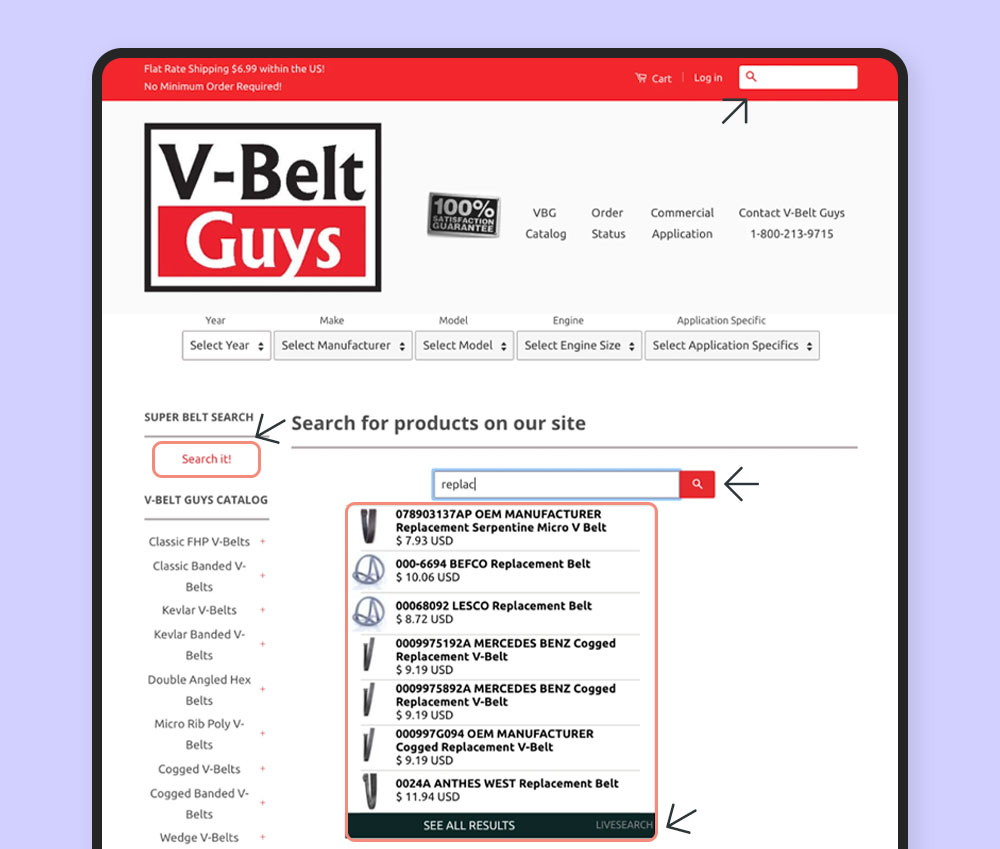
Customers who click "See all results" will have a full-screen experience with pricing comparisons, larger photos, and thorough product descriptions.
V-Belt Guys supplies their visitors with essential search components such as:
~The part number.
~Brand or manufacturer.
~Part of or the full product title.
~Product classification (e.g., product use cases).
~Item specifics (for example, width, function, and "number of teeth").
This critical service offering will reassure customers that your B2B ecommerce company can assist them in finding exactly what they need quickly. That's a value offer that encourages recurring purchases, which is becoming increasingly difficult to provide online.
Make Wholesale Simple for Loyal Customers
Some B2B buyers choose simplicity over the bells and whistles of B2C ecommerce in the case of independent retail establishments, small-to-medium franchises, and B2C outlets.
Catering to these buyers entails providing a digital version of the spreadsheets and faxed purchase forms they are accustomed to. Including all of the bells and whistles of B2C can be a distraction, if not harmful.
According to Pierre Verrier, Director of Design and Development at Noticed:
"The most common misconception about wholesale ecommerce is that it is difficult to get your sales channel up and to operate. Using a Wholesale Channel is a quick and easy approach to start selling and provide your consumers with an excellent ordering site."
The Elephant Pants, for example, strikes a similar balance between B2B and B2C via their wholesale ecommerce platform. This features a lot of the previously mentioned B2C aspects, such as an easily accessible search bar, rapid access to prior Orders, an online catalogue for browsing, and transparent pricing:
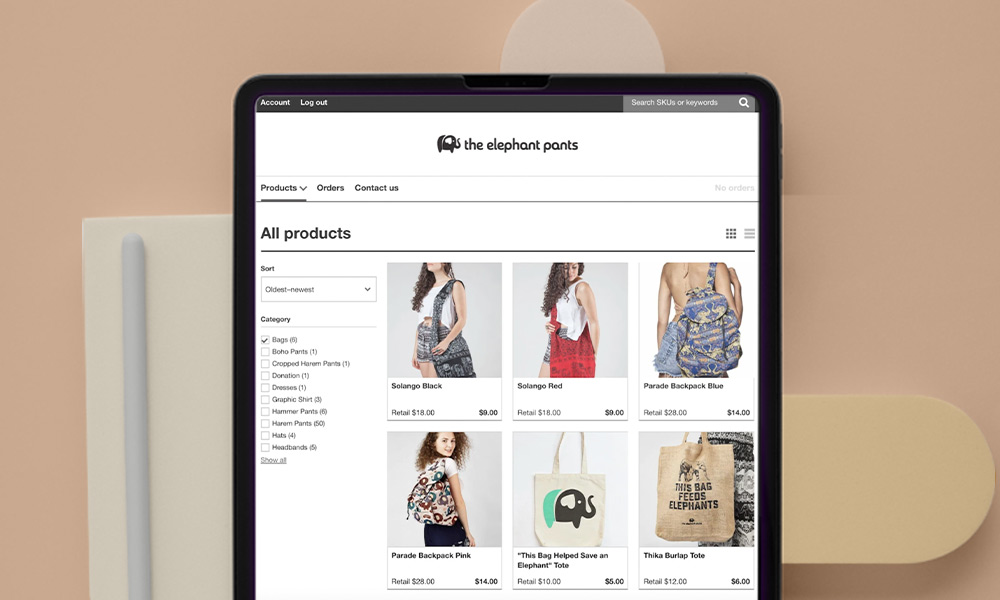
According to James Brooks, CFO and founder of The Elephant Pants:
"At first, some of our retail partners opposed an online wholesale platform." For us, the shift was about replacing our haphazard system of phone calls and Quickbooks with something more efficient. The human direction was still vital to them.
"In reality, we're in it with our sellers. We give clients purchasing and marketing guidance, spec sheets and POS displays."
"Because their assistance was critical, we hired a superb sales rep and combined the physical with the digital."
"Today, we assist 80-90% of our buyers in placing orders through the wholesale channel." The terms are decided on an individual basis for each buyer. As a result, wholesale has doubled for us in the previous two months week on week."
B2B must sometimes provide more than B2C. Sometimes less is more.
Less is more regarding resellers, small-to-medium franchises, and B2C businesses. The more traditional your site, the more straightforward the order process. When your orders get complex, such as with customisations, different versions, or fulfilment alternatives, the B2C approach shines.
Everything is determined by the customers you serve. However, before we can help those who can make bargains, we must first study those who can break them.
Create B2B Leads with 'Agnosticism'
Seth Godin used the term "permission marketing" over ten years ago to define the "luxury (not the right) of delivering anticipated, individualised, and relevant communications to individuals who genuinely want to get them."
Even though Godin created the word, the permission ethos was far from novel. How to be successful in life and business has always had worth at their foundation. Not value in the product itself — that should go without saying — but value before the product.
BBDO VP and creative director John Caples wrote in the early 1930s:
"The finest advertisements appeal to the reader's self-interest, that is, that benefit the reader." They provide readers with something they desire – and can obtain from you."
What was true back then is true today...even more so
This involves generating leads with "provider agnostic" sales collateral in B2B. That may seem counterintuitive, but customers are essentially self-interested. The traditional approach of leading with material that enhances your product, solution, or value proposition makes it all about you.
The Challenger Customer powerfully frames the issue:
"This is a significant shift for marketers." Following this content strategy will move the focus from supplier-centric to supplier-agnostic for the bulk of content categories you produce."

Lead generation should focus on two sorts of problems significant to your target customers' businesses rather than supplier-centric collateral:
~Problems that they are aware of
~Problems they are not yet aware of
The key takeaway is that B2B ecommerce lead generation cannot begin with you; it must start with your customer.
A content-based strategy can be used by businesses to funnel people from various pain points to their products. Consider your content pipeline as follows:
~Recognise — to educate purchasers
~Choose – to help you make a purchase decision.
~Implement — for post-transaction assistance
When visiting your website, new consumers can learn more about their issues and potential solutions. Instead of marketing, your goal should be to raise necessary awareness so that the consumer places a genuine value on fixing their problem.
Of course, in many circumstances, stories outperform feature lists and product specs. As a result, much of the B2B marketing we perform is focused on the customer rather than the product.
Instead of making the product the star of the story, we want the business to be the hero:
By persistently focusing on the challenges your market suffers, you drive yourself to abandon self-centred sales and marketing and win the "permission" of your future customers before the sales process begins.
Amy Barzdukas, CMO at Polycom, once said:
"Those [content] initiative leaders were nurtured with in-depth educational information to assist them to grasp the benefits of cooperation and how to evaluate different solutions." This technique allowed us to establish a trustworthy relationship to provide traditional, sales-focused follow-up such as demos and product specifications."
"By developing content for each stage of the buyer's journey, we can reduce sales cycles, increase conversion rates, and grow our marketing-sourced funnel and income."
Success entails obtaining "permission" at the top of the funnel and then going down the funnel by overtly selling the collateral.
Social Media May Help You Humanise Your B2B.
Despite its indisputable rise in B2C shopping, social networking still needs to be discovered by B2B companies. Direct-to-consumer networks like Facebook, Instagram, and even LinkedIn are primarily considered as such.
Nonetheless, according to the Content Marketing Institute's 2020 B2B Report, social media remains the primary organic content distribution method used by B2B marketers:
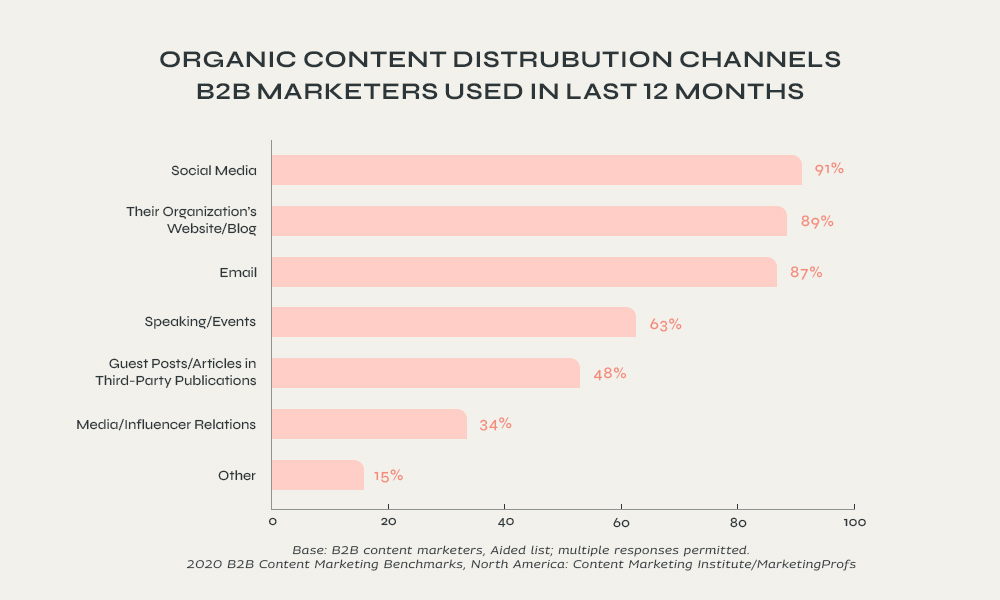
While social media does not work for direct sales in B2B, it is an effective tool for outreach and building the kind of agreement B2B decision-making requires. Why? Because consensus is about people connecting with people.
"Social selling," explain Laurence Minsky and Keith A. Quesenberry in How B2B Sales Can Benefit from Social Selling, "focuses on developing focused content and delivering one-to-one communication between the salesperson and the buyer." Rather than developing an attachment for the organisation's brand, the salesperson should cultivate a relationship with each prospect, offering advice and answering inquiries."
Rest assured that effective social selling — developing native content for multi-channel marketing — only requires salespeople (or brands) to devote 5-10% of their time to one-on-one engagement.
That is not to imply that "brand affinity" isn't practical. Such ties may begin as fun, but they must also progress.
Price Using Automation and Negotiation
According to the most recent Forrester data, 74% of B2B buyers now do "at least half of their job purchases online." Furthermore, 53% of the purchases are made online.
What does this greater reliance on ecommerce mean?
"Today's B2B buyers demand that B2B eBusiness and channel planning specialists match the price transparency, immediacy, and convenience fundamentals of B2C enterprises like Amazon."
As previously stated, this does not imply that B2C and B2B experiences are identical. The word that stands out in Forrester's assessment is "price."
The balance here is price personalisation, which is automated (i.e., dynamic) for purchasers in the research phase and negotiated for those closer to purchasing.
This is fantastic news for B2C retailers considering expanding into B2B or wholesale. Instead of reinventing the wheel, an appealing B2B site should incorporate the best practices that your current site already offers.
The first is automatic pricing. This provides a straightforward solution by eliminating the requirement for discount codes. Scripts can be used to alter prices in real-time based on variables such as quantity, size, customer tags, and product combinations:
Pricing for the second type of transaction negotiated arrangements must be adapted to each customer. This contains:
~Making several price lists for fixed, percentage, or volume discounts.
~Applying those lists to individuals or groups of customers.
~Establish minimum, maximum, and quantity increments for each product.
~Setting minimum purchase amounts for the entire store or per customer.
~Reviewing draught orders for negotiated deals before invoicing.
~Automatically integrating loyalty and incentive programmes.
Closing Words
As you can see, B2B ecommerce is an excellent approach to gaining new customers and boosting revenue for your company. A B2B ecommerce platform can help you get there, whether creating an online storefront, strengthening inventory management, or optimising your recordkeeping process.

